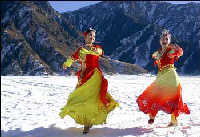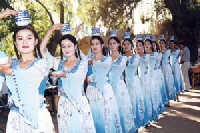
The most celebrated music inXinjiangtoday is Uygur folk music, which has inherited the fine traditions of the ancient music of Qiuci, Gaochang (Karahoja),Yizhou, Shule and Yutian.
Due to the particular geography of Xinjiang and the constant influence of one culture on another, musical styles have developed along different paths over the years, and each tradition is typical of its locality. There are three distinct styles of Xinjiang music: Southern Xinjiang, Eastern Xinjiang and the Daolang area.
Southern Xinjiang is vast, and the content and form of its music varies from place to place. For example, Hotan folk songs are simple, short and primitive, reflecting the flavor of the land.Kashgarfolk songs, however, have a sophisticated rhythm, while Kuqa folk songs are lively, boisterous and perfect for dancing.
In Eastern Xinjiang, folk songs have the same structure as those of Han's and Mongolian folk songs.
Dolan area folk songs, from the western edge of the Tarim Basin, have an unrestrained style, retaining the mood of its ancient herdsmen.
In the Ili area, a large number of Uygur immigrants have helped to develop yet another style of Uygur music represented by drawn-out soulful tunes. A number of their songs are narrated and chantable.
There are several kinds of traditional Uygur music, the most famous of which is the classic Uygur musical composition the "Twelve Muqam", a major force in the development of Uygur folk music. This artistic gem combines folk music and dancing, and includes more than 340 classical songs, folk songs and pieces of dance and instrumental music. It has enticed people in both Northern and Southern Xinjiang for generations. Changing from overtures to allegrettos, followed by allegros, "The Twelve Muqam" lasts more than 20 hours. The piece was systematically recorded and published a few years ago.
 Another kind of Uygur music is called "Sanam," or "beauty," which involves singing and dancing to a group consisting of between seven to a dozen pieces of song-and-dance music. The music begins slowly and steadily, then picks up speed, and finally culminates in a climax of merry music and exuberant dances.
Another kind of Uygur music is called "Sanam," or "beauty," which involves singing and dancing to a group consisting of between seven to a dozen pieces of song-and-dance music. The music begins slowly and steadily, then picks up speed, and finally culminates in a climax of merry music and exuberant dances.
"Kuxak," "Eytixish," and "Maida" are spoken songs, which are common among the Uygur people. Accompanied by simple tunes, the speaker will talk his way through a song, usually about the love between a man and a woman. These songs can also be performed by two people.
Uygur music is accompanied by a variety of instruments. Back in the Sui (581-618) and Tang (618-907) dynasties, the five-stringedpipa(a plucked string instrument with a fretted fingerboard) andkonghou(harp, an ancient plucked stringed instrument) were popular in Qiuci and other areas. They arrived in the Central Plains along with music from the Western Region. The present Uygur music developed from ancientmusical instrumentsfrom the Western Region as well as modern Chinese and foreign instruments; it includes dozens of stringed, wind and percussion instruments.
 The Mother of Uygur Music: 'Twelve Muqam'
The Mother of Uygur Music: 'Twelve Muqam'
Known as the "mother of Uygur music," the "Twelve Muqam" has a long history. Some scholars believe its origin can be traced back to the "Great Western Region Melody" that flourished during the Han (206BC-AD220) and Tang dynasties and enjoyed a high popularity in Central China.
In the mid-16th century, aided by other experts, the imperial concubine Amannisahan of the Yarkant Kingdom, who was also an esteemed poetess and musician, devoted all her efforts to collecting and compiling Muqam music, which was then scattered across Uygur-populated areas. She finally worked out 12 grand, yet light and entertaining compositions that are now known as the "Twelve Muqam."
 The music of other ethnic groups is no match for the gigantic and neatly arranged system of the "Twelve Muqam."
The music of other ethnic groups is no match for the gigantic and neatly arranged system of the "Twelve Muqam."
Strictly following the astronomical almanac, each of the "Twelve Muqam" is divided into three parts: Cong Naghma, Dastan and Mashrap, each with 25-30 sub-melodies.
The whole set of the "Twelve Muqam" consists of 360 different melodies and takes over 20 hours to play in full.
While Muqam is a musical form that has spread in Islamic areas throughout the world, the "Twelve Muqam" carries distinct Uygur characteristics.
What is significant about its compilation is that Amannisahan did not borrow material from the wealthy and fully developed Arabian and Persian repertoires. Instead, she exploited the rich resources of Uygur folk music spread out in the wide area in the north and south of the Tianshan Mountains. As a result, the "Twelve Muqam" is especially distinct due to its strong Uygur flavor.
Since its spread among the Uygurs, the "Twelve Muqam" has played an inseparable role in the people's lives. They dance to the accompaniment of "Twelve Muqam" and sing songs and ballads to its melodies.
After the founding of new China (1949), the local government of the Xinjiang Uygur Autonomous Region made every effort possible to preserve the "Twelve Muqam."
In 1956, Muqam master Turdi Ahun and musician Wan Tongshu, working with other assistants, took great pains to record most of the vocal melodies and librettos of the "Twelve Muqam" on tape. They also recorded the music by hand.
 Their efforts paved the way for the renaissance of this cultural tradition.
Their efforts paved the way for the renaissance of this cultural tradition.
In 1960, two volumes of "Twelve Muqam" sung by Turdi Ahun were published. The oral cultural heritage was finally secured in the form of its first publication.
Over the past two decades, local Xinjiang cultural institutions have sponsored seminars, supported research projects and published a number of books with the "Twelve Muqam" as the focal theme.
Over the past four years, 7,000 performers -- many of them Uygurs -- participated in the national key publication project. Their concerted efforts have resulted in the release of CDs, VCDs and DVDs of the "Twelve Muqam of Uygur."

Presented by Chinadaily.com.cn Registration Number: 10023870-7
Copyright © Ministry of Culture, P.R.China. All rights reserved